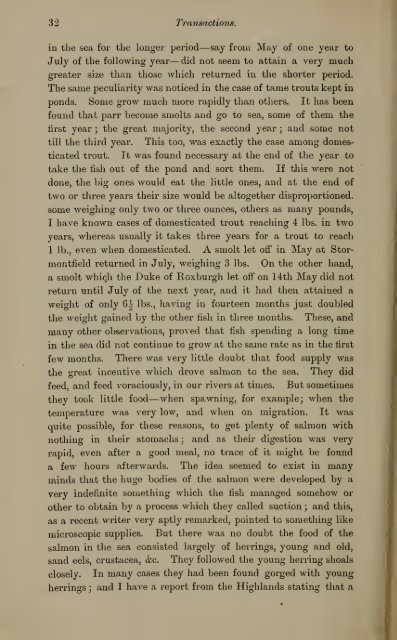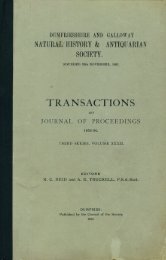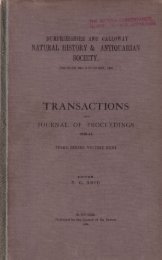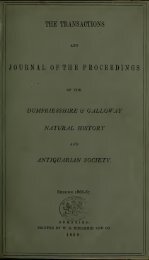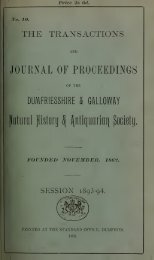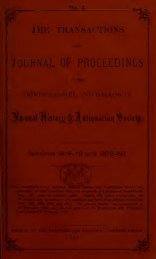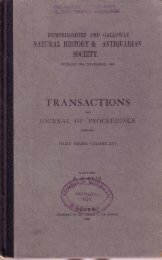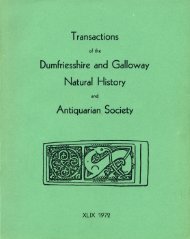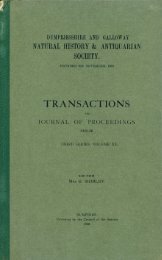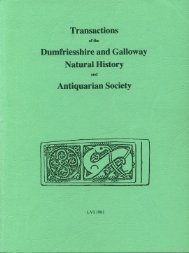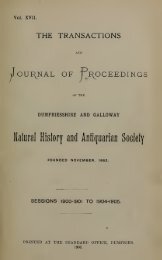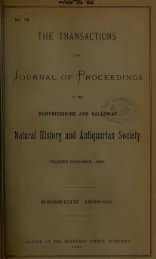Vol 5 - Dumfriesshire & Galloway Natural History and Antiquarian ...
Vol 5 - Dumfriesshire & Galloway Natural History and Antiquarian ...
Vol 5 - Dumfriesshire & Galloway Natural History and Antiquarian ...
You also want an ePaper? Increase the reach of your titles
YUMPU automatically turns print PDFs into web optimized ePapers that Google loves.
32 Transactions.in the sea for the longer period—say from May of one year toJuly of the following year— did not seem to attain a very muchgreater size than those which returned in the shorter period.The same peculiarity was noticed in the case of tame trouts kept inponds. Some grow much more rapidly than others. It has beenfound that parr become smolts <strong>and</strong> go to sea, some of them thefirst year ; the great majoi-ity, the second year ; <strong>and</strong> some nottill the third year. This too, was exactly the case among domesticatedtrout. It was found necessary at the end of the year totake the fish out of the pond <strong>and</strong> sort them. If this were notdone, the big ones would eat the little ones, <strong>and</strong> at the end oftwo or three years their size would be altogether dispro^iortioned.some weighing only two or three ounces, others as many pounds,twoI have known cases of domesticated trout reaching 4 lbs. inyears, whereas usually it takes three years for a trout to reach1 lb., even when domesticated. A smolt let off in May at Stormontfieldreturned in July, weighing 3 lbs. On the other h<strong>and</strong>,a smolt which the Duke of Roxburgh let off on 1 4th May did notreturn until July of the next year, <strong>and</strong> it had then attained aweight of only 6| lbs., having in fourteen months just doubledthe weight gained by the other fish in three months. These, <strong>and</strong>many other observations, pi'oved that fish spending a long timein the sea did not continue to grow at the same rate as in the firstfew months. There was very little doubt that food supply wasthe great incentive which drove salmon to the sea. They didfeed, <strong>and</strong> feed voraciously, in our rivers at times. But sometimesthey took little food—when spawning, for example; when thetemperature was very low, <strong>and</strong> when on migration. It wasquite possible, for these reasons, to get plenty of salmon withnothing in their stomachs ; <strong>and</strong> as their digestion was veryrapid, even after a good meal, no trace of it might be founda few hours afterwards. The idea seemed to exist in manyminds that the huge bodies of the salmon were developed by avery indefinite something which the fish managed somehow orother to obtain by a process which they called suction ; <strong>and</strong> this,as a recent writer very aptly remarked, pointed to sometliing likemicroscopic supplies. But there was no doubt the food of thesalmon in the sea consisted largely of herrings, young <strong>and</strong> old,s<strong>and</strong> eels, Crustacea, &c. They followed the young herring shoalsclosely. In many cases they had been found gorged with youngherrings ; <strong>and</strong> I have a report from the Highl<strong>and</strong>s stating that a


